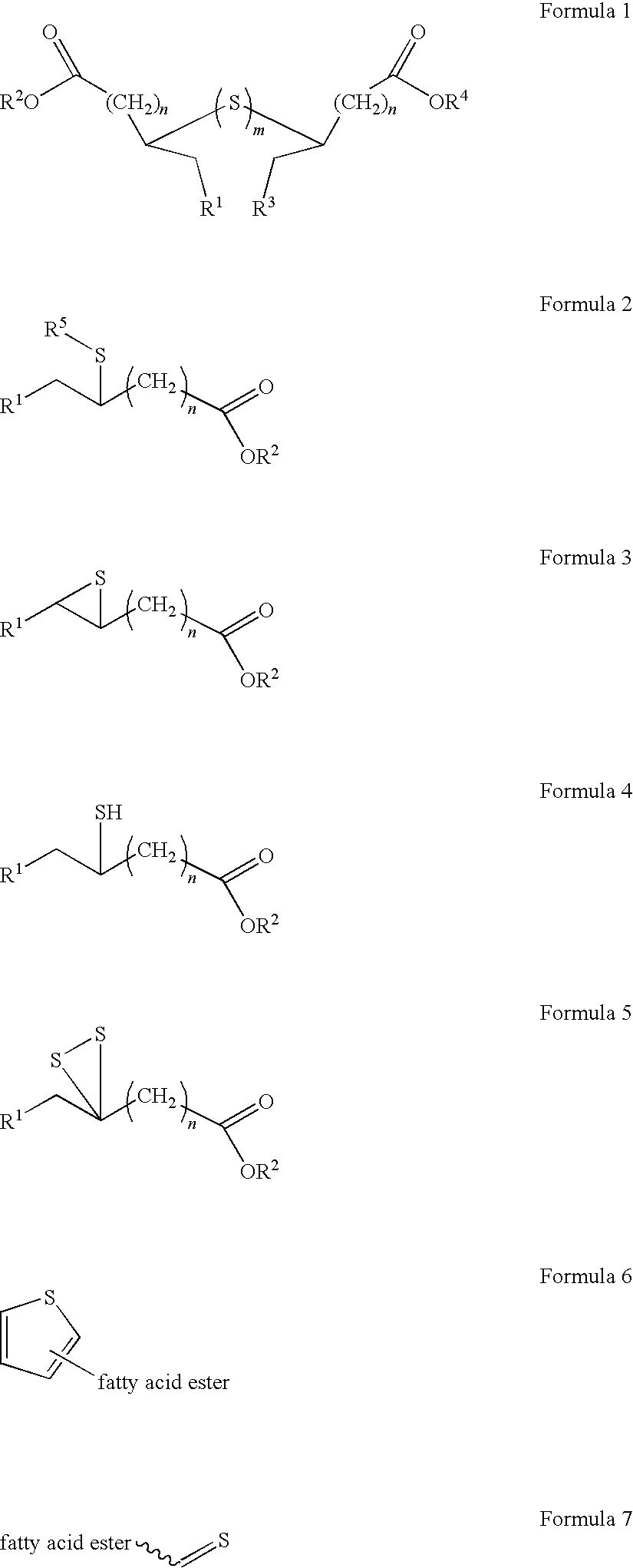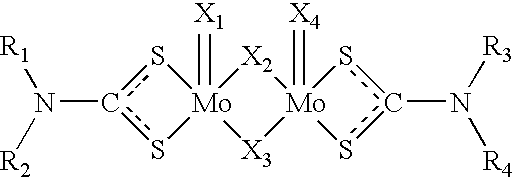Lubricating Oil Composition
a technology of lubricating oil and composition, applied in the field of lubricating oil composition, can solve the problems of increasing performance requirements, reducing the amount of dihydrocarbyl dithiophosphate metal salts, and exhibiting detrimental effects of the same additive in another aspect, so as to improve the fluidity at low temperature
- Summary
- Abstract
- Description
- Claims
- Application Information
AI Technical Summary
Benefits of technology
Problems solved by technology
Method used
Image
Examples
example 1
[0102]The formulations set out in Table 1, were subjected to the IIIG engine test according to the method ASTM D3720-07 Standard Test Method for Evaluation of Automotive Engine Oils in the Sequence IIIG, Spark-Ignition Engine. Viscosity increase and valve wear were measured.
[0103]The sulfurised fatty acid ester used in the examples was Dover Chemical's Base 10SE. The quoted amounts are in mass % active ingredient.
TABLE 1TestOil 1Oil 2AdditiveLimitmass %mass %Sulfurised fatty acid ester1.01.0Molybdenum Dithiocarbamate0.009Dispersant3.3003.300Calcium Sulphonate Detergent (300BN)1.6001.550ZDDP0.9600.960Aminic / hindered phenol antioxidant0.7000.550mixtureAntifoamant0.0010.001Group II base stock80.58580.734Group III base stock9.9009.900Group I base stock0.9330.933Viscosity modifier1.0211.063Boron, ppmMolybdenum, ppm05Sulphated ash, mass %0.4640.464Phosphorous, mass %0.0770.077Sulfur, mass %0.2600.258Viscosity increase at 100 hours, %150%94.294.3max.Weighted piston deposit merits3.54.783.8...
example 2
[0105]The oil specified in Table 2 was subjected to a copper corrosion test, ASTM D130-04e1 Standard Test Method for Corrosiveness to Copper from Petroleum Products by Copper Strip Test. It can be seen that despite the presence of the sulfurised fatty acid ester, the lubricant still passes the copper corrosion test.
TABLE 2AdditiveOil 4, mass %Dispersant3.20Calcium sulphate detergent (300BN)1.60ZDDP0.96Aminic antioxidant0.50Sulphurised Ester1.04Molybdenum Dithiocarbamate0.10GMO friction modifier0.15ETA FM0.125Antifoamant0.002Viscosity Modifier7.800BasestockBalancePhosphorous, mass %0.077Sulfur, mass %0.270Sulphated Ash, mass %0.464Molybdenum, ppm55Boron, ppmD130 (2B Max.)1B
example 3
[0106]The oils set out in Table 3 were investigated for their compatibility with nitrile seals using the method described in ASTM D7216-05 Standard Test Method for Determining Automotive Engine Oil Compatibility with Typical Seal Elastomers. The performance was measured against the projected GF-5 requirements.
TABLE 3ProjectedOil 5,Oil 6,Additivelimitsmass %mass %Sulphurised ester1.0001.000Molybdenum0.0500.000dithiocarbamateDispersant2.6603.300Calcium sulphonate1.6001.600detergent (300 BN)ZDDP0.9600.960Amininc / hindered phenol0.4000.250antioxidant mixtureAntifoamant0.0020.002Base stockBalanceBalanceSulphated Ash, mass %0.4640.464Phosphorous, mass %0.0770.077Sulfur, mass %0.2600.260Mo, ppm280B, ppmHNBR-1: Volume−5.50.570.34change, %HNBR-1: Hardness−5.510change, %HNBR-1: Tensile strength−20.10−3.1−10change, %HNBR-1: Elongation−35.0−26.5−31.2change, %HNBR-1: Change in−10.351.51.27tensile strength at 50%elongation, %
[0107]It can be seen that passing results were achieved with or without m...
PUM
| Property | Measurement | Unit |
|---|---|---|
| mass % | aaaaa | aaaaa |
| mass % | aaaaa | aaaaa |
| mass % | aaaaa | aaaaa |
Abstract
Description
Claims
Application Information
 Login to View More
Login to View More - R&D
- Intellectual Property
- Life Sciences
- Materials
- Tech Scout
- Unparalleled Data Quality
- Higher Quality Content
- 60% Fewer Hallucinations
Browse by: Latest US Patents, China's latest patents, Technical Efficacy Thesaurus, Application Domain, Technology Topic, Popular Technical Reports.
© 2025 PatSnap. All rights reserved.Legal|Privacy policy|Modern Slavery Act Transparency Statement|Sitemap|About US| Contact US: help@patsnap.com



